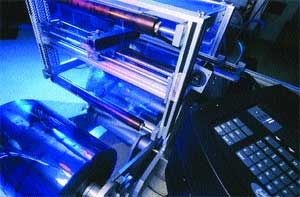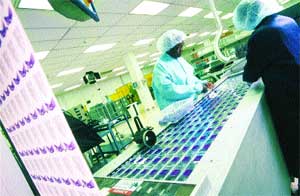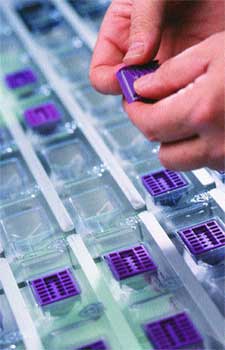Blister packaging stanches flow of germs to medical device
March 11, 2015
Chances are, you know someone who is walking around with a ligating clip permanently located in their body as a result of a surgical procedure. And, having captured 70 percent of the worldwide manual ligation clip market, Weck Closure Systems of Research Triangle Park, NC, is probably the manufacturer of that device. Furthermore, if the clip is made from a plastic polymer, no doubt it's Weck's new Hem-o-lok®.
More than 30 years ago, Edward Weck was the first to develop and patent the ligating clip as a replacement for sutures to block off blood vessels that had to be cut during surgery. Weck's introduction of the Hemoclip ligating clip, along with a surgical instrument used to insert the clip, called an applier, provided surgeons with a fast, efficient and secure method of binding blood vessels during surgery before dissection to control bleeding–a technique known as "ligation."
Because they are human-implantable, ligating clips are governed by strict regulations from the Food & Drug Administration. Sterilization of these devices is essential. With the introduction of its Hem-o-lok product in '99, Weck sought packaging that could not only provide the necessary sterilization features, but that could also offer functional benefits. Closing up the deal was blister packaging made from Klöckner Pentaplast of America, Inc.'s Pentamed® transparent, blue-tinted polyethylene terephthalate glycol film.
The seal of assurance
The Hem-o-lok polymer ligating clip–one of the most thoroughly tested devices in Weck's history–is the culmination of a careful analysis of ligation users' needs and years of intense research and development. For such a product, packaging integrity was vital.
To sterilize the clips and the appliers, Weck uses ethylene oxide (EtO) in a technique in which a lethal gas is used to kill all known viruses, bacteria and fungi, annihilating even the most sterilization-resistant types of microorganisms–bacterial spores. EtO can seep into even the tiniest openings in the medical device–in this case, the Hem-o-lok–and kill any organisms living there. Tough on microbes, EtO still treats most medical materials gently, even with repeated use.
|
During blister-pack production, above, large rolls of PETG film comprising the lower web are fed through a f/f/s machine to form the blister cavities. Loaded clip cartridges, with six ligating clips per cartridge, are then placed into the cavities, as shown at the top of the page. |
According to Kim Kasdorf, packaging engineer for Weck, EtO sterilization is a hazardous process, and Environmental Protection Agency regulations for governing the technique get tougher all the time. "One of the advantages of using Pentamed film is its stability," he says. "It works well with EtO and also with gamma radiation."
The Hem-o-Lok blister-pack is constructed of 20-mil Pentamed MD-E678/00 PETG film, made from resin supplied by Eastman Chemical. The film's transparent quality allows a nurse or technician to see the seal better and verify its integrity, thus offering assurance of the package's sterile barrier.
The film was also chosen for its silicone-free composition, according to Richard Ryder, business manager for Klöckner Pentaplast's medical device films. "Because Weck performs its own packaging, Hem-o-lok cartridges are thermoformed, filled and sealed as individual units," he says. "This means silicone isn't required to denest the tray, since there is no shipping required to another location."
Building on success
Spurring the use of Pentamed for its Hem-o-Lock blister packaging was Weck's previous experience with the material for packaging its line of Horizon metal ligating clips, sterilized using gamma radiation. Says Kasdorf, "We already owned the custom toolset for our Multivac R5200 form/fill/seal machine for packaging our Horizon brand of ligating clips, so we configured the Hem-o-lok to use the same blisters, made from Pentamed." As with the Horizon package, each Hem-o-lok blister package holds 14 plastic cartridges, each of which contains six Hem-o-lok polymer plastic clips.
Weck uses three Hem-o-lok blister sizes with a fourth, the newest and largest "XL" size, to be launched within the next few months. Existing "MLX" and "ML" clip sizes are packaged in the same-size blister, which resembles an upside-down house with two sidewalls and a pitched roof. The "SMX" blister is smaller but similar in design. The new "XL" will have the same configuration, but is a bit larger than the "ML/MLX" size.
|
Operators place loaded clip cartridges into formed blister cavities, after which lidstock is applied. |
Lidstock consists of DuPont's Tyvek®1073b high-density polyethylene film, on which is printed the product description and other required information. All of the blisters use the same sealing tool and the same cutting system, so overall, they have the same flange dimensions of 3.65 x 2.01 in., with corners on the radius.
Making it easy for surgeons to identify the correct clip size with the appropriate type of applier when using a variety of clip sizes in a surgical procedure, Weck has created a color-coding system. Medium is signified by blue, medium-large is green, and large is purple. The corresponding color appears on the blister packaging, the cartridge, the lidstock and the applier. "This color-coding system lets the nurse or technician see through the transparent, blue-tinted film to determine what size they are supplying to the doctors performing the surgical procedure," says Kasdorf. "It's another reason that the clarity of the packaging film is important."
During production of the blister-packs, large rolls of the PETG film comprising the lower web are fed through Multivac R5200 f/f/s machines to form blister cavities. Loaded clip cartridges are then placed in the cavities. Next, lidstock is applied to the lower web and sealed around each cavity with Oliver Products' 18B adhesive. The web is then cross-cut, and rounded corners are punched out, leaving strips of sealed blisters. In the last stage, rotary knives cut the strips into individual blister-packs.
Primary packaging uses functional design
Primary packaging for the clips consists of color-coded cartridges from Avail, each holding six devices. Made of colored acrylonitrile-butadiene-styrene (ABS), the cartridges come in four sizes to fit the different clip models and consist of two pieces: a color-coded base and a natural-colored PE clip retainer. As for the cartridge design, form follows function. Based around the clips, the cartridges are designed so that the devices can be held securely, yet can be easily seen and dispensed. Because Hem-o-lok cartridges are asymmetrical, cartridge bases are also asymmetrical. They have "V" notches and end flanges on one side so the surgeon will know how to load and orient the clips for application to the surgical site.
Also for convenience, cartridges are designed with a two-sided tape backing that allows the surgeon to place the cartridge wherever it is most convenient, e.g., on the drape, on his/her hand, or on the patient's chest.
The PETG savings
By standardizing the use of Pentamed film, Weck is realizing savings through efficient inventory management and bulk pricing. The company employs a "Demand/Pull" inventory system that bases production orders on forecast and demand. When supplies get down to a certain level, Weck contacts Klöckner Pentaplast with a new order. This just-in-time type of shipping arrangement saves on warehouse space by storing only what is immediately needed, which in turn reduces overhead warehouse costs.
Therefore, Weck heavily relies on Klöckner Pentaplast's trucking company to deliver film on short notice–a process made even more expedient by the fact that the two companies share a state border. Says Jeff Haggerty, Weck's director of supplier management, "We're business partners in a sense; they are a critical supplier. Without Klöckner Pentaplast film, we'd be stopped dead."
Kim Kasdorf adds that he was involved in a company audit of Klöckner Pentaplast, and its responsiveness was astounding. "It's a world-class company," he says. "Not every ISO 9000 or 9002 is world-class. Klöckner Pentaplast provides tremendous delivery. They've jumped through hoops to get us film, which is of consistent high quality."
|
Primary packaging for the clips consists of color-coded cartridges made from ABS that come in four sizes to fit the different clip models. |
Another cost savings resulting from the use of PETG is the reduction of scrap during the production process. According to Klöckner Pentaplast's Richard Ryder, this results from having gloss on both sides of the film. "Consistency of the film produces higher yields in the machine," he says. "Good thickness and width tolerances give Weck little scrap."
Another benefit to Weck of using standard medical device packaging is that it facilitates worldwide regulatory approvals. Recyclability becomes a political touchpoint in Europe, where the company's customers are environmentally sensitive. The recycling of PETG film also becomes more of a cost issue in Europe. Germany, in particular, requires a company to agree to take their waste back if it is not recyclable. Made of virgin material, Pentamed film packages get a green dot because they are recyclable. Overall, there is less waste because there are no carbon specs or debris in the film.
And, Pentamed's film clarity and printability provide marketing advantages, as well. Says Glenn Hoskin, director of Weck's marketing, "I care about graphics on the package because of brand recognition. Doctors need to recognize the product." That's important because Hem-o-lok is marketed at conventions, exhibits and workshops throughout the world attended by the doctors who eventually specify and use the clip.
No news is good news
For Kasdorf, not hearing any criticism from the field about the Hem-o-lok package is high praise, and so far, he hasn't gotten one negative comment. "Especially when dealing with medical devices," he says, "packaging, when done properly, is something the customer won't notice. I think we have achieved that with the packaging for Hem-o-lok."
More information is available:
Film: Klöckner Pentaplast of America, Inc., 540/832-3600. Circle No. 201.
PETG resin: Eastman Chemical Co., 800/327-8626. Circle No. 202.
F/f/s machine: Multivac, Inc., 800/800-8552. Circle No. 203.
Lidstock: DuPont Medical Packaging, 800/448-9835. Circle No. 204.
Adhesive: Oliver Products Co., 616/456-7711. Circle No. 205.
Cartridges: Avail, 866/552-2112. Circle No. 206.
About the Author(s)
You May Also Like





